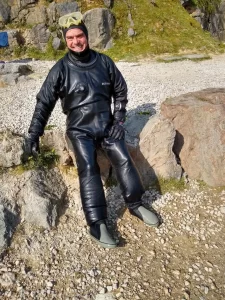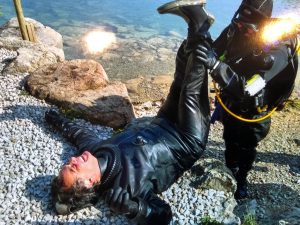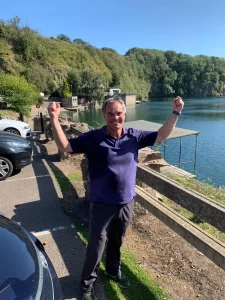Members Stories
What's It Like To Learn To Scuba Dive With Sheffield Scuba?
Author: Barry Warne
Date: 2nd Oct 2019



As I was approaching retirement towards the end of last year I thought I would have a go at scuba diving, the plan being to do the training over the winter months and dive properly after that, if I liked it. I arranged a “try dive” at Ponds Forge one Wednesday evening and was shown how to descend to six metres and resurface, and how to clear my ears to avoid pain from water pressure. My instructor was Tessa. She was calm and patient; and I felt very safe with her. It turns out she is the Chair of the club!
Afterwards I was not sure about signing up as a member, mainly because of ear pain during the try dive and having a head full of water for two days afterwards, but also because I do something else on the night (Wednesday) the club has the diving pool at Ponds Forge. So I asked for another try dive and enjoyed that too; it was with Matt who turned out to be the club’s Diving Officer. He was also very calm and patient and inspired confidence like Tessa had done. My ears soon got used to the pressure too.
I then joined BSAC and paid the club membership fees, and, with half a dozen other Trainees, attended the theory classes for an hour on several Wednesday evenings, then went to the pool for some practical training and then the pub afterwards. The other members were very friendly and happy to share their experiences as divers. The theory exam was straightforward as I had listened in the lectures and read the course manual; most of it is a combination of GCSE Physics and common sense. My problems were more with the practical side of things, such as the kit.
The kit
I soon realised that during my try dives, I had been supplied with pre-assembled diving kit which someone else had kindly put together for me. On subsequent dives at Ponds Forge I learnt how to put the breathing gear together myself, with help from other trainees and the ever-helpful instructors and other members. The main things are an air cylinder, a buoyancy jacket (with loads of straps) which the diver wears and to which the cylinder is attached, and a set of breathing tubes called a regulator or “Reg” which deliver air to the diver via a mouthpiece. I probably made all the mistakes which can be made, including struggling to fasten all the straps the right way or even at all, forgetting to put my mouthpiece back in when descending after a chat on the surface (I came back up again pretty quickly) and causing a loud bang having failed to purge the air out of my buoyancy jacket at the end of a dive one evening. I have learnt from these mistakes and everyone is always very understanding.
One thing I noticed was that I always arrived at the pool tired after work and sometimes a theory lesson (the pool sessions start at 9pm) but by the end of the pool session I was much more alert and “buzzing”; so it was invigorating and doing me some good.
Open Water and Capernwray quarry
The theory and pool training are just the prelude to the real thing: proper diving, i.e. not in a pool, known as Open Water diving. In a pool you can see where you are, where the sides and bottom of the pool are and where the surface is, so it’s hard to lose track of where you are; and it’s nice and warm. In a lake or the sea these advantages disappear in whole or part and obstacles appear, too. The water is often very cold and you are in it a long time, so you have to wear more layers, normally a tight-fitting drysuit (which isn’t much different from a spacesuit) over normal scruffy clothes. Often the club’s Open Water dives are at a diving centre called Capernwray near Carnforth, about two hours’ drive from Sheffield. It’s a flooded former quarry, filled with things to find like metal horses and sunken plane wrecks. The first time I went there we were going to wear drysuits, wear weights and dive much deeper than six metres. I was worried about several things, especially ear pain, and buoyancy (going down too fast or coming up too fast) as I had never used a dry suit before and already had enough trouble with my buoyancy jacket! I would have to control my buoyancy using two devices instead of just one. But I was confident that the instructors (Tessa and Tim) would look after me; and indeed they did. The dive went fine and I loved it. We did two dives, one in the morning and another after lunch, practising the rescue skills we had learnt in the pool and exploring the lake a bit.
At one point, we were about eight metres down next to the edge of an underwater cliff. It was murky and I could hardly see anything. Tim signalled that we were going to descend (swim off the cliff and down) so we all did. I was going down deeper than I had been before, I didn’t know where I was going and I could hardly see anything. But I just trusted the instructors and followed them. It should have been scary but I loved it. (I never got to do that sort of thing in forty years sitting in my office.)
Getting cold at Capernwray
On another dive at Capernwray with two different instructors (Matt and Chris) I made yet more mistakes with my kit. On the morning dive I messed up putting on my dry suit so that cold water leaked in through one arm. This just made my clothes wet so I changed for the afternoon dive and put my drysuit back on again. On entering the water (very cold water, maybe nine or ten degrees) I felt an inrush of cold water from my neck down my chest. I told the instructors about this so they rigorously checked my suit for leaks. This amounted to dunking me unceremoniously under the water and looking for bubbles. There weren’t any, so no leak; so we proceeded to dive on the basis that if I got cold I would say so. After maybe half an hour I was feeling pretty cold (but OK) so we agreed to finish the dive and head for the surface. By the time we got to the surface a few minutes later I was very very cold and couldn’t work my hands properly, or talk properly, and had difficulty breathing while swimming on the surface. It emerged that my “dry” suit had been flooded with cold water since soon after the start of the dive, but I hadn’t noticed as we were under water and I wasn’t used to what a flooded suit felt like, and I don’t feel the cold like some people do. When I got out of the water with the help of the instructors and my diving buddy Louise, everyone could see that my dry suit was baggy rather then tight-fitting as it was full of cold water. Chris “emptied” me by (again, unceremoniously) lifting my legs off the ground so water could spill out of the back of the unzipped suit. Quite a crowd of divers gathered round to see and film this rare event. All I could do was laugh my head off. It was an hour before I stopped shivering but other than loss of dignity I had no ill-effects.
The key thing about this flooding incident was that I was never in any danger. The dive was ended safely and we all surfaced and came back to the shore. If I had been in any danger under water I was still in the safe hands of the two instructors and my buddy who would have brought me up and ashore.
A pair of gloves?
Probably the daftest thing I have done was to complain to Tessa (when we were about to enter the water for our second dive of the day) that I had two right gloves and no left glove. I asked my buddy if she had got one of mine by mistake. Tessa pointed out gently that my left glove was inside out so it looked like another right glove. They had both looked like right gloves to me.
The three things I want to emphasise about learning to dive with Sheffield Scuba are these. First, the rule is safety first, fun afterwards. Until a trainee has mastered the basics of buoyancy, mask clearance, use of the equipment and basic rescue skills, he/she is not let loose in Open Water, and even then the instructors and your buddy take good care of you. Second, the instructors are brilliant. They are amazingly tolerant of trainees who can’t do things or who do daft things and they are calm, patient and very capable divers. Third, although it’s safety first, there is a lot of fun to be had and the divers are all nice people of all ages who share a love of the sport. They like nothing better than planning a dive trip to somewhere with warm, clear water and then telling other divers about it and showing the photos. So, give it a go!
